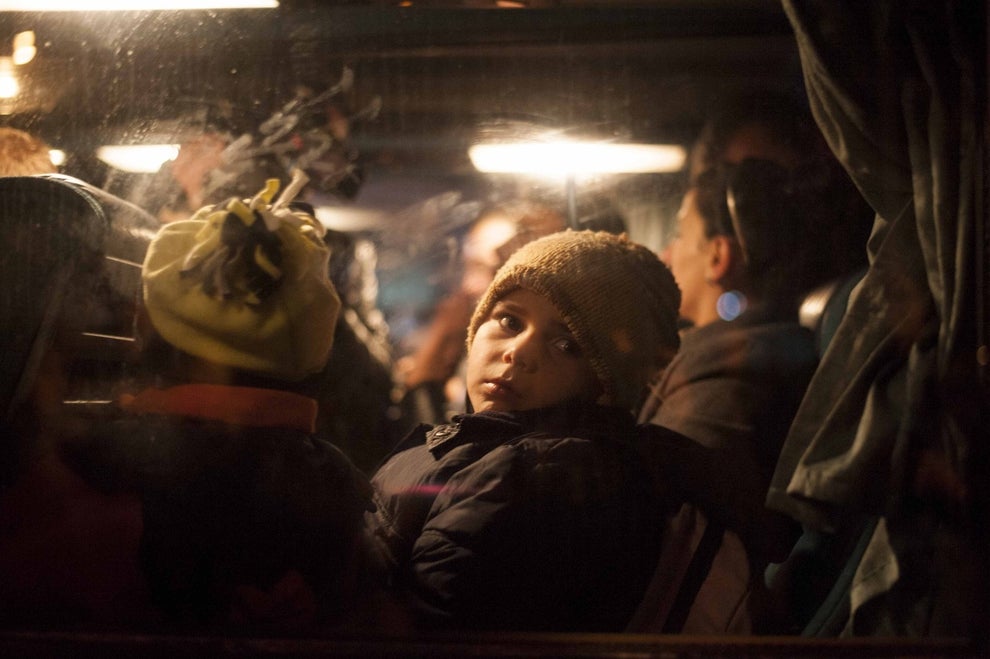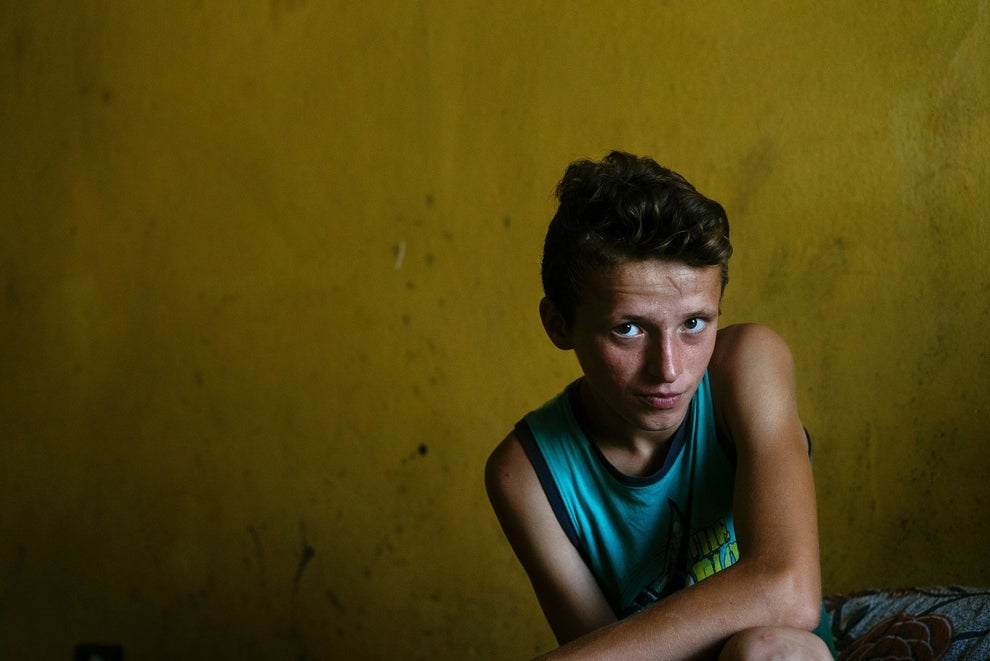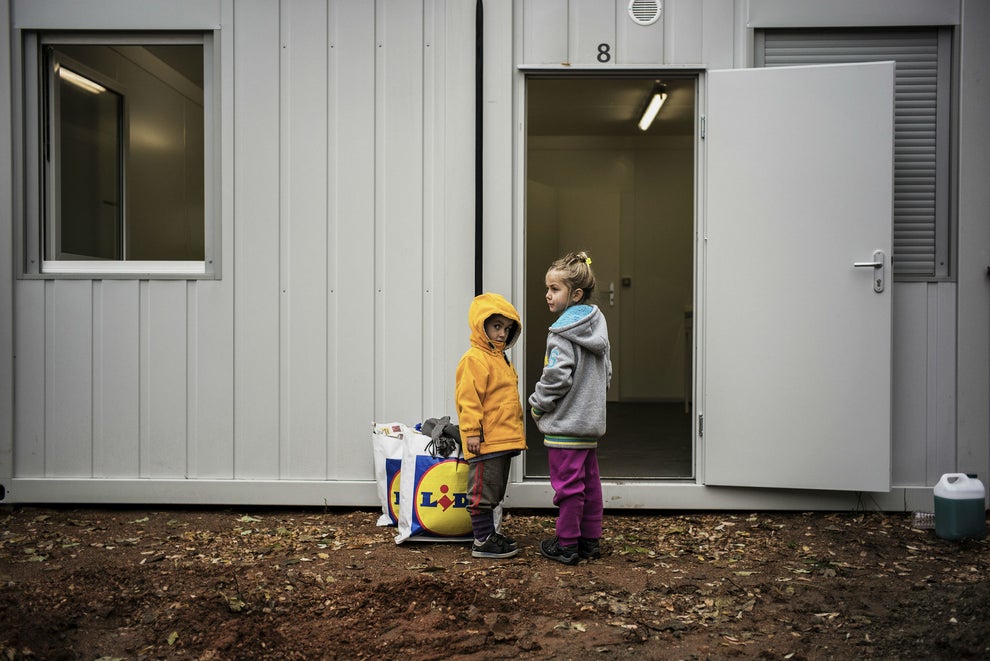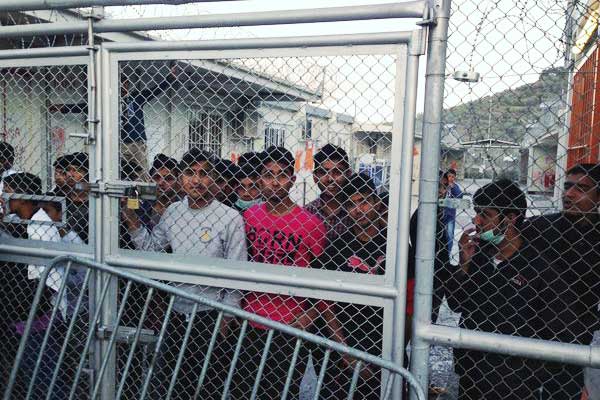"Se un bambino sta fuggendo da un pericolo nel suo paese d'origine e bussa alla nostra porta, implorando aiuto, abbiamo il dovere di aprire la porta."
IN the past 15 months, at the request of President Obama, Mexico has carried out a ferocious crackdown on refugees fleeing violence in Central America. The United States has given Mexico tens of millions of dollars for the fiscal year that ended Sept. 30 to stop these migrants from reaching the United States border to claim asylum.
Essentially the United States has outsourced a refugee problem to Mexico that is similar to the refugee crisis now roiling Europe.
“The U.S. government is sponsoring the hunting of migrants in Mexico to prevent them from reaching the U.S.,” says Christopher
Galeano, who spent last summer researching what’s happening in Mexico for human rights groups there. “It is forcing them to go back to El Salvador,Honduras, to their deaths.”
I went to Mexico last month to see the effects of the crackdown against migrants, who are being hunted down on a scale never seen before and sent back to countries where gangs and drug traffickers have taken control of whole sections of territory. More than a decade ago, I rode on top of seven freight trains up the length of Mexico with child migrants to chronicle hellish experiences at the hands of gangs, bandits and corrupt cops who preyed on youngsters as they journeyed north. Compared with today, that trip was child’s play.
In a migrant shelter in Ixtepec, Mexico, I met July Elizabeth Pérez, 32, who was clutching her 3-year-old daughter, Kimberly Julieth Medina, tight in her arms, and keeping a careful eye on her two other children, 6-year-old-Luis Danny Pérez and 12-year-old Naamá Pérez. She arrived at this shelter after fleeing San Pedro Sula, a city where she grew up and worked as a waitress but that is now the deadliest town in Honduras, a country with one of the highest homicide rates in the world.
She was aiming to reach the United States, where her mother and grandmother live legally in Florida — 3,000 miles away.
She got less than 300 miles inside Mexico’s southern border to the migrant shelter, and that took 20 terrifying days. Four times, Mexican state and federal police stopped buses she and her children were on. She cried. She bribed them. Other times, she and her three children got out of taxis or buses to walk around checkpoints.Photo

July Elizabeth Pérez with one of her daughters, 3-year old Kimberly Julieth Medina, and her only living son, 6-year-old Luis Danny Pérez, at the Hermanos en el Camino shelter in Ixtepec, Mexico. CreditKate Orlinsky for The New York Times
After walking 12 hours around a mountain, they waited, exhausted, for seven days until a freight train left. July hid in a cubbyhole at the end of a freight car with her children, but 15 minutes later some men stopped it and shot toward those aboard. “Sons of bitches, we are going to kill you!” they yelled at the migrants.
Some migrants on the train threw rocks at them; in the chaos, July and her children were able to escape. By the time they arrived at the shelter, she had spent $3,000 sent by her grandparents and mother in the United States on bribes and wildly inflated prices charged by buses and taxis to reach the shelter on July 23. Two days later, she applied for a humanitarian visa to get through Mexico to reach her mother in Miami. She has been waiting two months.
“I think Mexico is putting up as many obstacles as possible so you despair, give up, and leave,” she says.
The crackdown has changed the shelter, Hermanos en el Camino, like many church-run immigrant shelters in southern Mexico, from a place migrants stopped for a quick bite and respite to a refugee camp where migrants wait for months, desperately hoping to get a visa or asylum from Mexico that would allow them to stay or safely continue north.Photo

The shelter Hermanos en el Camino, which is used for sleeping at night and to escape the sun during the day, when people relax, play cards and hold church services on Sundays. CreditKatie Orlinsky for The New York Times
By day, some 150 migrants erect buildings to expand the shelter, chop firewood, clean, take care of one another’s children. At night, the dozens who cannot cram into overcrowded dormitories throw thin mattresses under the canopy of the huanacaxtle tree, in the dirt, in hammocks slung between branches. There’s a cacophany of snoring in the courtyard. A woman kidnapped by bandits in Mexico and raped in front of her husband sobs.
For eight years, July’s family has been struggling with the gang and narco-cartel violence that has overtaken many areas of her country. On Oct. 29, 2007, her brother, Carlos Luis Pérez, a skinny 22-year-old, was kidnapped and then found dead two days later in a sewage ditch, his hands and feet cut off. He had been on his way to deliver the family’s $91 in rent money when he was robbed.
In 2010, July’s mother left legally for the United States with a visa that her mother had obtained for her. When July’s mother arrived in the United States, she quickly applied for a visa for July, vowing, despite long backlogs for such visas, to get July out soon, too. “Hurry!” July begged, “I don’t want anything to happen to my children.” Matters grew worse in her city; there were three mass murders in the two blocks near her house as neighbors and friends were killed by the 18th Street gangsters who ruled her area.
Not long after her oldest son, Anthony Yalibath Pacheco, turned 14, he told July that 18th Street gangsters ordered him to be their lookout. “No,” he told them, “my mom will be mad at me.” Terrified that her son was in danger, she tried in 2014 to get any kind of visa from the United States Embassy; both her October and November applications were denied. She was told to wait for her mother’s visa to be processed, something that can take years.
On Dec. 4, 2014, at 7 p.m., she sent the 14-year-old and his friend on an errand just steps from home. When he didn’t return immediately, July called, then texted. Her son did not respond.Photo

July Elizabeth Pérez holds a photo of her son Anthony Yalibath Pacheco, who was killed in Honduras by gangs last year when he was 14 years old. CreditKatie Orlinsky for The New York Times
Desperate, she went to the police station, pleading for help even though she knew they were in collusion with the gang. They found her son’s bike at a house that reeked of marijuana, although no trace of the gangsters — tipped off, July believes, by the police. They found the boys’ bodies nearby moments later. Her son had ligature welts on his wrists, his face was beaten, ribs kicked, and burn marks singed his lips. His body had been stuffed into a garbage bag. Another bag over his head had suffocated him. Her son loved to help others, study math, and take care of his younger siblings, she says, and he longed to be a lawyer. “Why didn’t they leave him alive? Why? Why?” She sobs, tears streaming down her cheeks.
July quickly buried her son in a spot on top of the grave of her brother who had died, abandoned her house, and went to live three hours away. Seven months later, a neighbor tipped her off that the gang had found her. She left in less than 24 hours, carrying little. Speed was crucial; many migrants have fled Honduras only to be traced and killed in Guatemala by the same gang there. In her haste to leave her home she left behind her passport and photos of herself.
She decided her only safe alternative was to go to the United States illegally, but she made it only a few miles inside Mexico before she and her children were caught and detained in the 21st-Century Migration Station, Mexico’s largest immigration detention facility, in Tapachula, Chiapas. Despite Mexican laws that require all detained migrants to be notified of their right to apply for asylum, no one informed her of her rights. She begged to be considered a refugee. “I cannot go back to my country!”
The detention center was packed. Her children slept on filthy mattresses. Her 6-year-old son’s arms were covered in a rash and bleeding. July’s asthma left her barely able to breathe. She begged for medicine. Twelve days after being caught, she was deported to San Pedro Sula, where both her son and brother had been murdered. She immediately headed north again, fearing that if she didn’t leave, the 18th Street gang would find her.Photo

Siblings Luis Danny Pérez, 12-year old Naamá Pérez and Kimberly Julieth Medina, play cards with another child fleeing violence, Anthony Douglas Ponce Barahona, 3, in the shelter's women's dormitory. CreditKatie Orlinsky for The New York Times
Beginning in July 2014, Mexico redirected 300 to 600 immigration agents to its southernmost states, and conducted over 20,000 raids in 2014 on the freight trains migrants ride on top of, and the bus stations, hotels and highways where migrants travel. In a sharp departure from the past few years, in the first seven months of fiscal 2015, Mexico apprehended more Central Americans — 92,889 — than the 70,448 apprehended by the United States. This year, Mexico is expected to apprehend 70 percent more Central Americans than in 2014, while United States apprehensions are projected to be cut by about half, according to a Migration Policy Institute study last month.
Of course, barriers will not ultimately stop children who are increasingly desperate and can find new ways around obstacles. In a worrisome development for the White House that another surge could be brewing, last month more than twice as many unaccompanied children were caught coming into the United States illegally and put in federal custody than a year ago.
Mexico has been particularly zealous in beating back children traveling alone. In the first seven months of this year, Mexico had already apprehended 18,310 minors, up nearly a third over the same period a year ago.
But unaccompanied minors feel they have no choice but to flee. At the Ixtepec shelter, Brian Enoc Pérez Molina, 16, says there is nothing left for him to go back to — the local narco cartel, which trafficks cocaine and marijuana, killed his brother and father. He tried to go home once, to an island off Bluefields, Nicaragua, and the narcos nearly bludgeoned him to death, too.
No one systematically tracks how many deportees end up dead when they are returned to their homes, but the social scientist Elizabeth G. Kennedy in a forthcoming report documents, from news reports, that at least 90 migrants deported by the United States and Mexico in the past 21 months were murdered. The true number, she notes, is most likely much higher.Photo

Willmer Villatoro, 16, and his brother Alexis Villatoro, 18, at the Hermanos en el Camino shelter. They fled gangs in El Salvador after Willmer was shot for not joining them.CreditKatie Orlinsky for The New York TimesPhoto

Willmer Villatoro's scar from a gunshot wound inflicted by gangs in El Salvador.CreditKatie Orlinsky for The New York Times
Although President Enrique Peña Nieto of Mexico said when he announced the so-called Southern Border Plan that it was to “protect the human rights of migrants as they pass through Mexico,” the opposite has happened. By the Mexican government’s own accounting, 72,000 migrants have been rescued from kidnappers in recent years. They are often tortured and held for ransom. The survivors tell of being enslaved working in marijuana fields or forced into prostitution. Many are killed — sometimes they have organs harvested — in what’s become an invisible, silent slaughter. The government push has been interpreted as open season on migrants who have become prey to an exploding number of criminals and the police who rob, rape, beat and kill them.
The crackdown has forced migrants to travel in ways that are harder, take longer, are more isolated and have fewer support mechanisms. New measures have made riding on top of freight trains north, a preferred method for anyone who cannot afford a $10,000 smuggler fee, incredibly difficult. In Tierra Blanca, Veracruz and elsewhere, tall concrete walls topped with concertina wire have been constructed to thwart migrants. In Apizaco, the Lechería train station outside Mexico City and elsewhere, chest-high concrete pillars, or rocks, have been installed on both sides of the tracks so migrants cannot run alongside moving trains and board them.

PhotoPeople head north in Chahuites, Mexico. It is one of the most dangerous areas along the southern migrant trail, where people are preyed on by criminals and fear officials monitoring the trains.CreditKatie Orlinsky for The New York Times
In Veracruz, low-hanging structures have been built that the trains pass through, so unsuspecting migrants atop freight cars are swept off moving trains. Mexican immigration officials are using tasers to zap people off moving freight trains, says Alberto Donis, operating coordinator of the Hermanos en el Camino shelter in Ixtepec.
Four in five of the migrants I spoke to at the Ixtepec shelter have walked most of the way, often with babies or toddlers in their arms.
“There are children walking the length of Mexico,” often at night so as not to be seen, says David Muñoz Ambriz, the Latin America communications manager for World Vision International, a Christian humanitarian aid group.
Migrants are also taking more clandestine, dangerous routes to go undetected, far from the dozens of mostly Catholic-run shelters that have sprung up next to the tracks to aid them. The Rev. Alejandro Solalinde, the priest who runs the Ixtepec shelter, has worked arduously to reduce abuses. He has been jailed by the police, threatened by narco traffickers, and lives with multiple bodyguards in daily fear for his life for denouncing barbaric crimes against migrants and complicity by Mexican law enforcers.Photo

A morning scene at the immigrant shelter in Chahuites, one of the most dangerous areas on the southern trail. CreditKatie Orlinsky for The New York Times
As Mexico has blocked refugees from moving forward, it places enormous obstacles in the way of being able to apply for asylum in Mexico. Those who are detained by migrant officials and are allowed to apply remain locked up during a process that can take months or a year, sometimes in jails where rats roam by day and worms infest the food migrants get. Of those who are able to hold out for a decision, only about 20 percent win — less than half of the roughly 50 percent asylum approval rate of the United States. Mexico granted asylum to 18 children last year.
“You can lock people inside a burning house, you can close the front door, but they will find a way out,” says Michelle Brané, director of the Migrant Rights and Justice program at the Women’s Refugee Commission. “The U.S. doesn’t want to recognize this as a refugee situation. They want Mexico to be the buffer, to stop arrivals before they get to our border.”
OTHER surrounding Latin American countries outside the so-called three conflicted Northern Triangle countries — El Salvador, Honduras and Guatemala — have seen an almost 1,200 percent spike in asylum claims between 2008 and 2014, according to a United Nations High Commissioner for Refugees study.Photo

A guide for migrants in Ixtepec issued by the National Institute of Migration (Instituto Nacional de Migración), a government organization that supervises immigrants. The pamphlet includes maps as well as safety and legal information.CreditKatie Orlinsky for The New York Times
While a legitimate debate can continue about the pluses and minuses of economic migrants to the United States, the solution with these refugees from our neighbors to the south is clear. It seems ridiculous to have to say it: If a child is fleeing danger in his or her home country, and that child knocks on our door pleading for help, we should open the door. Instead of funding only the current policies toward migrants in Mexico, we should fund fair efforts by Mexico to evaluate which Central Americans are refugees.
While migrants’ claims are evaluated, we should help Mexico pay for places for migrants to be held that are humane.
The United States should develop a system for these refugees, much like Europe is now doing for Syrians, to equitably allocate people who are fleeing harm throughout this continent — including sending them to safer countries in Latin America, to Canada and to the United States. In the 1980s, many United States churches stepped up to help Central Americans fleeing civil war violence, and many would gladly sponsor a migrant today if encouraged by our government.
Will the United States step up and be a moral leader for these refugees?
Sonia Nazario is the author of “Enrique’s Journey: The Story of a Boy’s Dangerous Odyssey to Reunite With His Mother.”
Di seguito riportiamo un interessantissimo articolo sulla situazione dei minori non accompagnati che provano ad attraversare la frontie...





 Bekim left Albania when he was a teenager. He was forced to flee after local mafia tried to shoot his father, he says. He made the long journey over land to Spain, and it was there Bekim – not his real name – met people-smugglers who wooed him with promises of a new life in the UK. But it would come at a cost.
Bekim left Albania when he was a teenager. He was forced to flee after local mafia tried to shoot his father, he says. He made the long journey over land to Spain, and it was there Bekim – not his real name – met people-smugglers who wooed him with promises of a new life in the UK. But it would come at a cost.

















